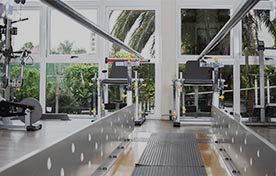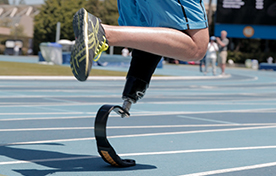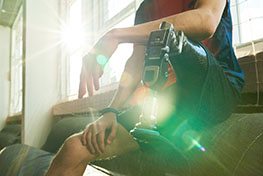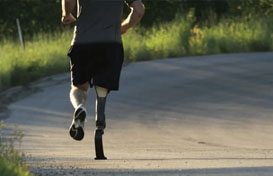Transfemoral Amputation, Part 5
– by Douglas G. Smith, MD

In the fifth and final part of our series on the transfemoral (above-knee) amputation level, we discuss some of the challenges and complexities of walking. We then examine the functions of the prosthetic knees and feet for transfemoral amputees and some new technological advances. Finally, we outline some thoughts on deciding whether you’re a high-tech, lowtech or no-tech type of person.
Swing and Stance
When we walk, one foot or the other is always in contact with the ground. Each leg is constantly transitioning, going from standing and supporting our weight to swinging through from behind to in front of us to get ready for the next step. The legs are always transitioning from stance to swing, which is why our walking motion is divided into what we call the “swing phase” and the “stance phase.”
The stance phase begins with “heel strike,” when your heel initially contacts the ground out in front of you. The foot then transitions into “foot flat,” when your weight comes over your foot. The knee is almost straight. As your body passes over the foot, your heel starts to rise behind you, and then your knee starts to bend. When just the tips of your toes are touching the ground behind you, you’ve reached the end of the stance phase.
Now you’re transitioning into the swing phase. Your knee continues to bend, your toes come off the ground, and your heel keeps rising behind you. As you move your pelvis and thigh forward, your prosthesis swings from behind you to underneath your body, all in a bent position. Finally, your leg swings out in front of you and your knee straightens so that when your heel touches the ground, your leg is straight and ready to accept your weight. You’ve reached the end of the swing phase and are transitioning into the stance phase again when your heel hits the ground.
There also are brief periods of time when both feet are on the ground and both legs are accepting some weight. Looking closely at this brief phase of our stride, we see that the toe of one foot is touching the ground while the heel of the other foot is also on the ground. That brief period of time is called “double limb support.”
Conversely, when we run, there are short intervals when both feet are off the ground. The definition of going from walking to running is that our gait changes from a pattern with a moment of double limb support to a pattern where both feet are briefly off the ground and we’re literally up in the air for a split second. In running, there’s no longer any double limb support. In fact, there’s just the opposite; there’s aperiod of no leg support. We’re actually airborne.
Examine your own stance and swing phases. You may be surprised at the intricacies involved in each step we take. Walking is something most of us do without much thought; it’s virtually automatic. But when you examine each phase of the stride, you will see what small, but complicated, interconnected motions are involved in getting one foot in front of the other. Our bodies really are biomechanical marvels. Many patients have told me that one of their major frustrations following a transfemoral amputation is the difficulty they have in learning to walk again. They’ve lost the physical parts that make these complex and intertwined motions automatic and subconscious. Bringing this complicated process back to the conscious level of thought requires a lot of work, but don’t get discouraged if progress comes more slowly than you’d like. As the philosopher Stanislaw J. Lee noted, “He who limps is still walking.”
Prosthetic Knees and Feet
The major differences between prostheses for a person with a transfemoral amputation and those for a person with a transtibial (below-knee) amputation are the knee unit and the foot. First, we’ll examine the knee unit and how it functions. At the end of this section, we’ll discuss feet and the erroneous concept that a prosthetic foot designed for a person with a transtibial amputation would also be optimal for a personwith a transfemoral amputation.
The simplest prosthetic knee joint is a basic hinge. Adjustable friction can be added to this hinge with the friction tuned so that swing phase occurs very smoothly at one walking speed. Next, weight-activated brakes can help prevent the leg from buckling when in stance phase. Knees with weightactivated brakes used to be referred to as “safety knees.” Now, they’re called “stance-control knees.” While these friction knee systems work well for people who walk at a single speed, big problems can occur for individuals who walk at different speeds.
When you’re walking slowly or if the friction is set too tight, your knee unit doesn’t bend enough when your toes come off the ground behind you, and your prosthetic foot will trip against the floor as your prosthesis swings under you. There simply is not adequate distance between the ground and your foot to complete the stride without tripping. Also, if the friction is too tight, your knee won’t straighten out in time at the end of the swing phase, your leg won’t get into position in front of you quickly enough for proper heel strike, and your knee will buckle because it cannot support weight while bent. You can spot those people whose knee friction is too tight. To avoid dragging their toes, they bring the prosthetic leg out to the side in a kind of half circle to keep from tripping. This is called circumduction.
A single setting can also be a problem when you’re walking faster or if the friction setting is too loose. Then your foot comes up a little higher than it should behind you during heel rise, and your leg snaps forward too strongly in front of you during follow-through. The leg reaches an exaggerated extended position too soon in the swing phase, and that makes it awkward to complete the stride comfortably. The prosthetic side appears to be bending far too much behind and snapping straight much too early in front. It looks very awkward.
To control these unwanted occurrences, prosthetic limbs were fit with hydraulic or pneumatic regulators. Hydraulic systems use liquid while pneumatic systems use air to control friction by speed. The faster a person brings the thigh forward, the more friction there is to control the lower leg. Friction prevents the leg from snapping forward too quickly. Conversely, the more slowly you move the same knee unit, the easier the motion. Think of a bicycle pump. If you push down on the handle very slowly, it moves smoothly and easily. But if you try to shove it down quickly, air resistance kicks in, and it takes a lot more exertion to move it. If a person with a prosthetic knee tries to walk really fast, it’s like pushing the bicycle pump down quickly. It will go, but it takes a lot more “oomph” to get it to move. It’s more resistant so the leg will slow down. When the person walks slowly, there’s less friction so the unit moves smoothly and the leg is where it is supposed to be throughout the stride. Hydraulic and pneumatic control units allow smooth gait at very different walking speeds.
Stability is very important during the stance phase and has improved over the years, thanks to slightly different technological advances. The initial advances involved a friction brake mechanism inside the unit. The more weight you put on it, the more resistant it was to buckling. With the weight unloaded, it became free to flex again. If your knee did not give freely after a certain point, you could not sit down without your leg sticking straight out in front of you. Then some units were designed so that the knees won’t buckle even when the loading happens with the knee bent between 5 and 15 degrees of flexion. This established an added range of stability and safety against buckling.
The next evolution has been to control the knee functions withmicroprocessor and computer control. Instead of having a setting only for speed, microprocessors can also instantly interpret the knee position and the loading forces so that the friction is constantly adjusting throughout the swing and stance phases. The older knee was in swing phase unless there was weight on it. Then as the little brakes were applied, it would go into stance phase. The newer knees are mostly in stance phase to prevent the person from falling and convert to swing phase just when the person loads weight onto the toe and also starts putting a bending force on the lower leg. The microprocessors sense all of these forces and allow the knee to then swing freely.
The newer microprocessor knees are much more resistant to buckling, and my patients tell me they have fewer incidents of stumbling and falling with them. I believe that these microprocessor knees are a great advance and have helped many individuals, young and old alike. While the current microprocessor knees certainly add improved control, another advance in knee units is still needed – a motor that provides lifting power. We’re headed in that direction, but we’re not there just yet.
A tremendous variety of prosthetic feet are available. With so many models, I wonder why people automatically assume that the type of foot that works best for a transtibial amputee would also be the best for a transfemoral amputee? It’s often not the case.
Jacquelin Perry is a renowned researcher from Southern California who was a physical therapist before she became one of the first women orthopedic surgeons in the United States. As she points out, many people with a transfemoral amputation prefer a prosthetic foot with enough ankle motion to get to “foot flat” quickly. Transfemoral amputees can have a greater sense of stability when the foot is flat against the ground. Elastic response feet preferred by many transtibial amputees don’t have the bending characteristic necessary to get to foot flat quickly. They’re just too stiff. Not only could a more flexible foot help some individuals with a transfemoral amputation have a better sense of contact with the ground, it could also allow a smoother transition from heel strike to toe off during the stance phase of gait. Conversely, Dr. Perry points out that the increased ankle motion that helps many transfemoral amputees often seems too soft or too mobile for many transtibial amputees. Their needs and desires can be different
Technology: The Expected and the Unexpected
It can be quite difficult for a person with transfemoral limb loss to walk on uneven surfaces and up or down slopes, ramps or stairs. Transfemoral amputees have to spend more time thinking about walking and scanning the terrain than do people with most other lowerlimb amputations. They are always onthe lookout for dangerous situations that might make them stumble or fall.
The newer microprocessor knees overcome some of the difficulties in walking on nonlevel surfaces, especially down hills and down stairs. And while these technological changes are improvements, measuring the impact of technology can be difficult. Physically, it’s clear to see when someone is walking more symmetrically than not. In a gait lab, we can measure the forces at work while walking. But, interestingly, we’re finding that having to consciously think about walking and issues such as stumbling and falling is more important than we had ever realized.
For many of us, walking is automatic without any real conscious thought. But as we’ve discussed, a person with a transfemoral amputation must think more about walking, especially on uneven surfaces or in unfamiliar areas. Different environments can bring different and sometimes hazardous challenges. It’s one thing to take a walk alone on an even, smooth path. It is quite another to navigate an area like an airport concourse, where people are walking at a great variety of speeds, stopping and starting, and coming at you from all directions. You have to make countless adjustments to your gait as you’re headed to or from your plane.
Technological advances have made it possible to better meander through situations like this. I know a female executive with a transfemoral amputation who does a lot of work-related travel. She says that airports used to be full of possible pitfalls because of crowds, turns and changing speeds. She says she really had to focus on walking when she got off the plane and headed for baggage claim. After she switched to a new knee unit with microprocessors, however, she found herself free to think about other things – where to find ground transportation, which hotel she was going to, reading signs and notes. She could concentrate on other things, unlike before when most of her mental energy was focused only on walking.
Technology can also free a person for the unexpected. Many transfemoral amputees do very little talking while walking because they must concentrate on both the mechanics of walking and the environment. Interestingly, one person who converted to a microprocessor knee told me that before she made the change she and her husband rarely talked while walking because she had to concentrate on walking. She says her husband really enjoyed those silent, contemplative strolls. Now that she’s converted to one of the new microprocessor knees, her bubbling personality comes out while they’re walking. Though her husband appreciates her newfound freedom, she says that he sometimes wonders what happened to the peace and quiet he used to enjoy on their walks.
These last two scenarios illustrate that the new technological advantages are not always obvious or easy to measure. When thinking about walking, most of us tend to focus on energy, the number of steps a person takes during a typical day, and other things of this nature. But the real value might be in minimizing stumbling and falling and freeing people to think about other things while walking – like listening to what your spouse is saying, for instance.
“The difference between a good walker and a bad one is that one walks with his heart, the other with his feet.”
– William Henry Davies, poet
High-Tech, Low-Tech and No-Tech Solutions
The recent decades have brought tremendous technological advances aimed at improving quality of life and ease of motion. Therefore, many people assume that the latest and greatest technology is always the best. Though technology offers solutions for problems, however, it’s important to keep in mind that there isn’t a single answer for everything. One knee system is not right for everybody. One socket system isn’t perfect for everyone. There isn’t a single suspension system that does the job for all. When it comes to people, there are high-tech, low-tech and no-tech kinds of folks. Remember our earlier analogy of the VCR. It can come with a wide array of options, but many of us are content to just push play, stop and rewind.
High-tech products are developed to solve problems, but they generally come with several “costs.” While cost is usually measured in dollars, the biggest impact on a person can be the emotional cost: the anxiety and fear that something will go wrong with the new technology, for example. Then there’s the “fiddle factor” – how often do I have to mess with this thing to make it work right? Circuits may go bad. What if the electronics get soaked in the rain? Batteries have to be plugged inand replaced so what happens when it runs out of “juice”? Is this new technology convenient for me? There’s a learning curve. You can’t just plug it in, push a button and go. Many new microprocessor legs are adjusted early in training, but later the software settings need to be readjusted as the person becomes more proficient and uses the device in different ways. It’s kind of like computer software upgrades. As you learn to use more and more of your computer, you have to keep changing the settings. Something that’s high-tech and fancy can require more work than something that’s simple but reliable.
“Computers are magnificent tools for the realization of our dreams, but no machine can replace the human spark of spirit, compassion, love and understanding.”
– Louis Gerstner, retired CEO, IBM
Other solutions might seem less “glamorous” because they’re not high-tech, but they’re stable and durable. There’s less gadgetry, fewer maintenance problems, and you can count on them to work when you need them. Some individuals simply love to rely on “old faithful.”
Ideally, each of us would have just the right amount of technology so that it helps us with our needs but doesn’t overwhelm us with its demands. Technology should be tailored to each person, and there’s a real art to finding the right balance. Some people even prefer not to use any technology at all.
One of the challenges in this next decade will be coming up with suggestions and protocols to appropriately match the right technology and right prosthetic design to the right person. We need to figure out who’s going to do better with a quad socket than with a narrow ML socket. Who will do best with which knee unit? As for feet, there currently are more kinds of prosthetic feet on the market than you can count. Unfortunately, there are very few guidelines that actually say which foot is the best match for a specific person’s needs. One size does not fit all.
There’s a vast spectrum of high-tech, low-tech and notech solutions and products, and each person is unique. I’m a big believer in technology. I think it does make our lives better, but I also realize that there can be practical reasons for doing things one way versus another. What Bob likes doesn’t work as well for Joe. And Mary’s preferences are different from Betty’s. One of the secrets to success following a transfemoral amputation is matching each person with the right technology or understanding a person’s desire to go forward with no technology at all. It’s your body. What’s best for you?
Disclaimer: The following information is provided and owned by the Amputation Coalition of America and was previously published on the website http://www.amputee-coalition.org or the Coalitions Newsletter, inMotion.








